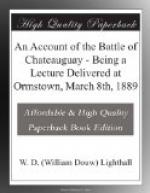Meanwhile, the enemy kept steadily moving along the road in column. A tall mounted American officer rode forward and began a harangue to the Canadians in French. “Brave Canadians,” said he, “give yourselves over; we do not wish to do you any harm!"[32] De Salaberry, seeing that his moment was come, sprang upon a stump,[33] discharged his musket as a signal to begin, and brought the American officer off his horse by the shot. The enemy at the time were exposed to being taken on both front and side. The bugles blared, the front companies immediately opened fire, and the battle was begun. Izard’s force were in the open plain, while their foes were hidden in a thick wood. The squadrons of cavalry and four cannon which they had brought thus far were found to be useless there. They, however, commenced a spirited[34] fire in battalion volley; but, from the position of the line, it was almost totally thrown to the right of the Canadians, and of no effect whatever. They soon faced to the right, and filing up with speed, changed their front parallel with the lines of breastworks, when the engagement became general, and their fire compelled the retreat, behind the front edge of the breastwork[35] of a few skirmishers near the left, who had been rather advanced in the centre of the line. This retreat being mistaken by the enemy for a flight, a universal shout ensued, which was re-echoed, to their surprise, by the Canadians and the Glengarry men in reserve under Lieut.-Colonel McDonell. Now was the supreme moment of the battle. De Salaberry ordered his bugleman to sound the advance. “This was heard by Lieut-Colonel McDonell, who, thinking the Colonel was in want of support, caused his own bugles to answer, and immediately advanced with two of his companies from the third and fourth lines to the first and second."[36] “All these movements were executed with great rapidity.” De Salaberry, at the same time, as a ruse de guerre, ordered “ten or twelve buglemen into the adjoining woods with orders to separate and blow with all their might."[37] The enemy, as De Salaberry calculated, suspected that the Canadians were advancing in great numbers to circumvent them. The Colonel, while giving these orders, is said to have done so facing his men, with his back against a tree.[38] The noise of the engagement towards its end brought on Colonel Purdy’s division on the opposite side of the river, which, having driven in the picquet of sixty Beauharnois Sedentary Militia under Captain Bruyere, were pressing on for the ford, whereupon De Salaberry ordered Lieut.-Colonel McDonell, who had returned to his position to check the enemy there, and Captain Daly was chosen, with the light company of the 3rd Battalion Embodied Militia, numbering seventy men,[39] to cross and take up the ground abandoned by the picket.




